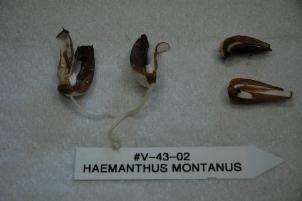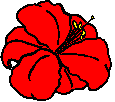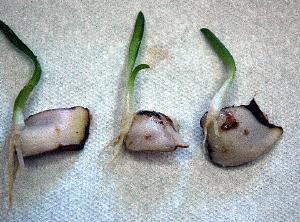
Haemanthus montanus corechips
 Shields
Gardens
Ltd.
Shields
Gardens
Ltd.| Home |
| Daylilies |
| Bulbs |
| Clivia |
| Seed Sales |
| E-Mail and Chat |
| Photo Gallery |
| Information |
| Sources |
| Guest Sites |
| Societies and Clubs |
| Links |
| People |
| About Us |
BulbAlert is an occasional e-mail newsletter sent to friends and customers of Shields Gardens Ltd. It contains announcements of bulbs or bulb seeds available for sale at the time of issuance. At other times, it contains notes and news about bulbs of general interest to Bulbophiles. The items reproduced here are from the latter group of newsletters.
To request a subscription to BulbAlert, please send your request, with the e-mail address to which your subscription should be sent, to: Shields Gardens Ltd.This is high summer in the Midwestern USA, and most of the bulbs are growing like mad. So I wanted to mention to you some pages in our non-commercial section of the web site.
I have a few of the commoner South African Crinum species illustrated on our web page at: http://www.shieldsgardens.com/amaryllids/Crinum.html and I have been adding species names to a supplementary page at: http://www.shieldsgardens.com/amaryllids/CrinumSpecies-2.html
I have no idea how many valid Crinum species there are in the world. I try to stay mainly with the South African varieties, since they tend to be better known than many from the rest of Africa and southern Asia. A site for the South African species is at: http://www.plantzafrica.com/plantcd/crinum.htm by my friend Dr. Robert Archer in Pretoria.
A couple other web sites that deal with Crinum and that you might enjoy visiting are: http://crinum.iconx.com/index.html on the crinums of Marcelle Sheppard, a site developed by Joe Shaw; and http://www.crinum.us/ developed by Al Sisk. Marcelle, Joe, and Al are all to be found in Texas.
Dr. David Lehmiller, another Texan, has explored southern Africa and Madagascar, searching for Crinum. His results have been published over the years since ca. 1992 in HERBERTIA, the journal of the International Bulb Society ( http://www.bulbsociety.org/ ). It's a real pleasure to hear him describe his trials and tribulations riding around the back country of far away countries in 4-wheel drive vehicles.
You can see what Crinum varieties we are offering at: http://www.shieldsgardens.com/Bulbs/SpringFall.html
We will have some fresh crinum seeds shortly. I don't yet know which species nor how many seeds of each there will be. Watch for announcements in Bulb Alert in the coming weeks or on our web page at: http://www.shieldsgardens.com/Seeds/CrinumSeeds.html
If you would like to receive future issues of "Bulb Alert," just send me your preferred e-mail address and be sure to request "Bulb Alert." The newsletter is available only by e-mail.
Best wishes,
Jim Shields
SHIELDS GARDENS LTD.
In the past, I have always started seeds of Hippeastrum and of most other Amaryllids with papery seeds by floating the seeds on water, under fluorescent lights. That still works fine for most Hippeastrum species and hybrids. Once the seedlings produce a green leaf about an inch long, they should be planted in a gritty potting mix for bulbs. Keep them loosely covered with clear plastic film (to maintain a fairly high relative humidity) and grow on under fluorescent lights. Water from below, letting the saucer become dry between waterings.
However, I have found that floatation does not do so well for a few forms. When I tried this with seeds of
Hippeastrum psittacinum
, the seeds germinated, producing a very short radicle, and then they died. On my next batch of seeds of H. psittacinum, I started them by inserting the pointed end of the seeds into a layer of sand about 1/2 to 1 inch thick, on top of my usual gritty bulb potting mix. The pot was covered with a clear plastic bag and placed in a saucer, on a shelf under fluorescent lights. The pot was used to water from below, and water was kept standing in the saucer.All the seeds germinated and have produced healthy young seedling bulbs with about 2 leaves per seedling.
I used a similar method with seeds of Hippeastrum reticulatum striatifolium. Since these seeds are round and fat, I planted them in the sand layer but left them slightly exposed to light. The pot was covered loosely with clear plastic. These seeds also germinated and produced seedlings.
I think that all Hippeastrum seeds could probably be germinated just as well using the sand layer over potting mix method. You would probably have to keep the pots covered, at least loosely, with clear plastic to ensure a high relative humidity.
Worsleya procera (also known as Worsleya raynori) is an amaryllid native to Brazil. It is fiendishly hard to grow in cultivation, at least outside of Brazil and New Zealand. It is sometimes call "the blue amaryllis" although it isn't quite blue, judging from the pictures I've seen of its flowers. It's very rare in nature and in cultivation.
Last Spring, I got a few seeds of Worsleya procera from a grower in Brazil. There were 5 seeds in the packet, at (I think) US$5.00 per seed. This was my very first experience with Worsleya in any form.
I planted them by sticking the pointed end of each into a layer of sand on top of my usual gritty bulb mix. The pot was covered with a plastic bag and placed in a saucer, then placed on a light shelf under fluorescent lights. The lights were about 4 to 6 inches (10 - 15 cm) above the pots, and were turned on for 16 hrs per day. Temperatures were pretty steady at about 72 - 76°F (ca. 22 - 24°C) days and somewhat cooler at night, when the lights were off. The pot was watered from below, and I kept water in the saucer. Three seeds appeared to germinate. One then died, while two formed leaves and tiny bulbs.
Right now, there are two bulbs sitting on the surface of the sand layer. Both had leaves, but now only one still has leaves. I put water in the saucer, intermittently. The pot is still sitting on the light shelf, under 16 hrs/day of fluorescent lights. The bulbs are ca. 7 - 8 mm in diameter by ca. 25 - 28 mm high.
This is my first attempt to grow Worsleya, and I don't really know what I'm doing here. I'm not at all sure where to go from here. I'm not optimistic about the prospects, especially when our summer comes, if I were to move the pot into the greenhouse, or outdoors in summer.
There is an Internet group dedicated to discussing Worsleya. You can find it in Yahoo Groups at http://groups.yahoo.com/group/Worsleya_procera/
Note: My "gritty mix" for bulbs is made up by mixing Promix BX + sand + granite chick starter grit in a ratio by volume of 2 : 1 : 1. Promix BX is a commercial Canadian product based on brown peat with apparently a little perlite and vermiculite added. The sand is a common brown construction grade of fill sand from local gravel pits. Granite chick starter grit is commercial clean granite chips ca. 1/8 to 3/16 inch (3 to 5 mm) in diameter.
By the way, I have offered to act as a dealer or distributor of Amaryllidaceae (Amaryllis Family) seeds in the USA for this Brazilian grower, but he says he has far too few seeds to support such an arrangement. He apparently cannot provide all his present customers with supplies of seeds of the less common Brazilian Amaryllidaceae, so I won't post his name or address here. Whenever I have enough Amaryllid seeds to offer for sale, I will announce them in Bulb Alert.
These are a couple of images of the experiment in propagating Haemanthus using bulb chips.

The H. montanus chips produced bulblets from the piece of basal plate attached to the bulb scales. The H. humilis hirsutus produced the bulblets from the outside surface of the scale, and the scales had no evident basal plate attached to them.

Best wishes,
Jim Shields
SHIELDS GARDENS LTD.
|
Bulbs-L The independent international list for bulb enthusiasts around the world. This list is private, non-commercial, and not affiliated with any particular society or group. Its remit is geophytes of the world (plants with bulbs, corms, tubers, or rhizomes). We welcome new subscribers. Bulbs-L is hosted by Surfnet in The Netherlands. |
|
International Bulb Society
|
|
Pacific Bulb Society The pbs list is a list sponsored by the Pacific Bulb Society that is open to people around the world who are interested in discussing bulb (more broadly geophytes) with a focus on how to grow them and use them in the garden. This list maintains the pbswiki, an interactive website we can all contribute to, where we show pictures of our plants and ones we have seen in the wild and share brief information about the same. We are interested in all bulbs, tender and hardy. |
|
Great Lakes Bulbs List This group has been replaced by the Bulbs-L list (see above). |
| Australian Bulb Association |
| General Information about bulbs |
|
| Orders: 1-866-449-3344 Toll-free |
|
| International: ++1-317-867-3344 |